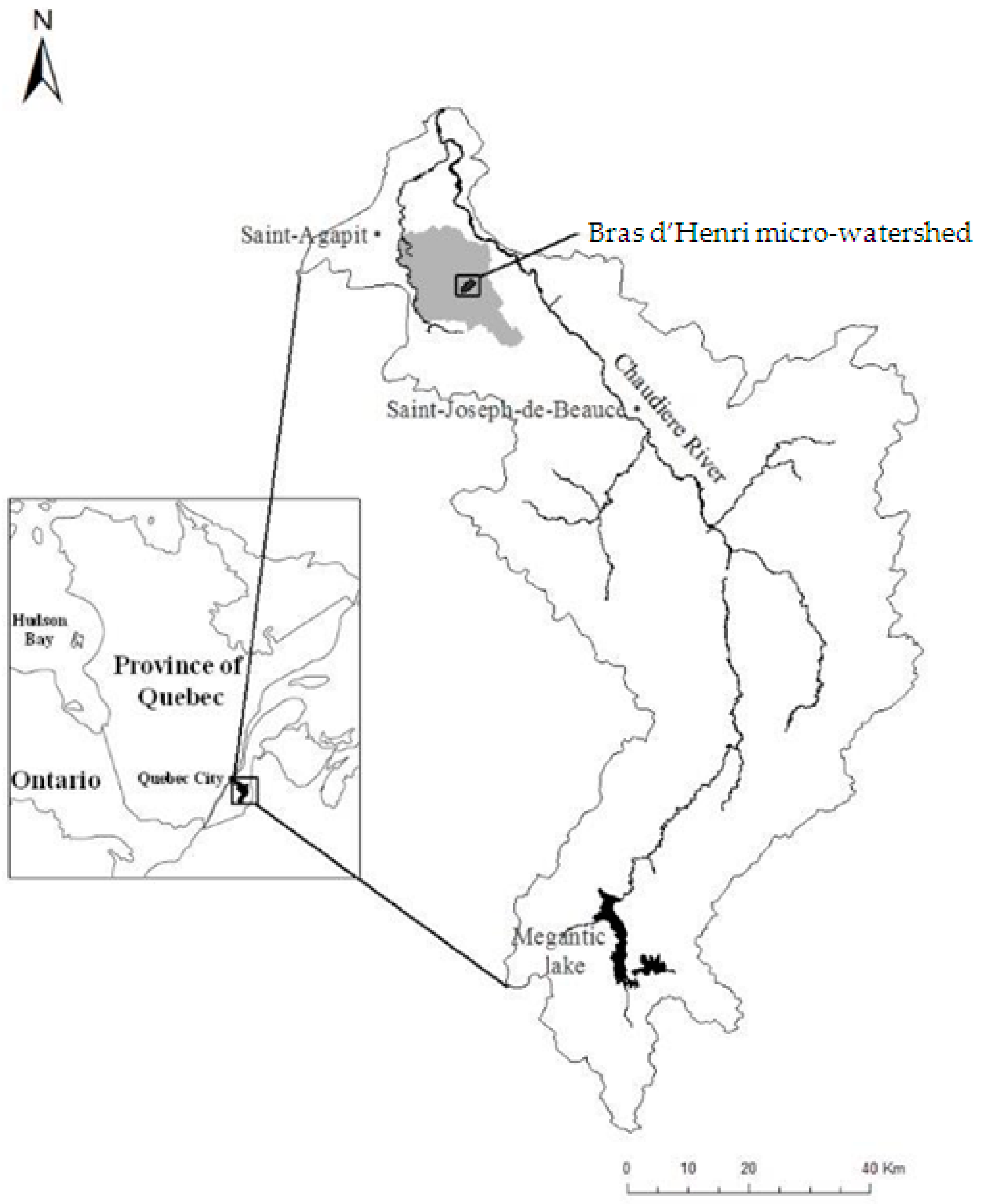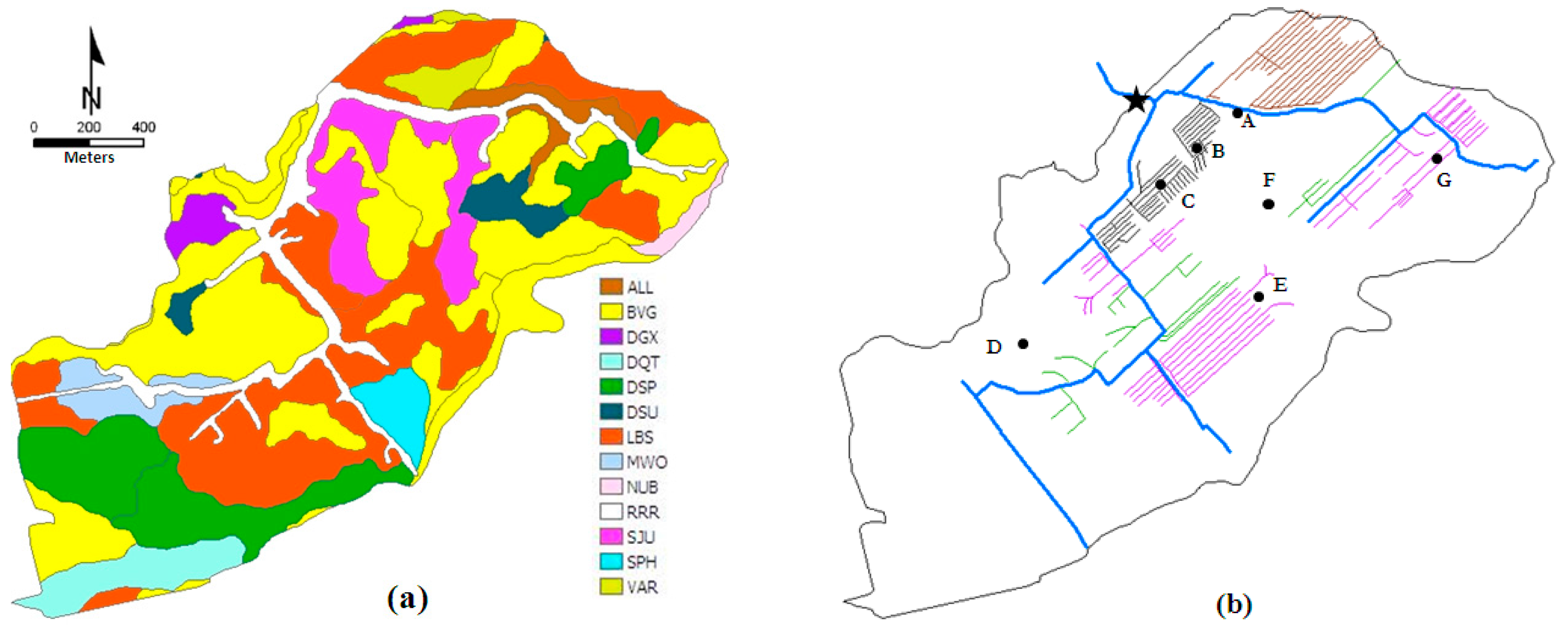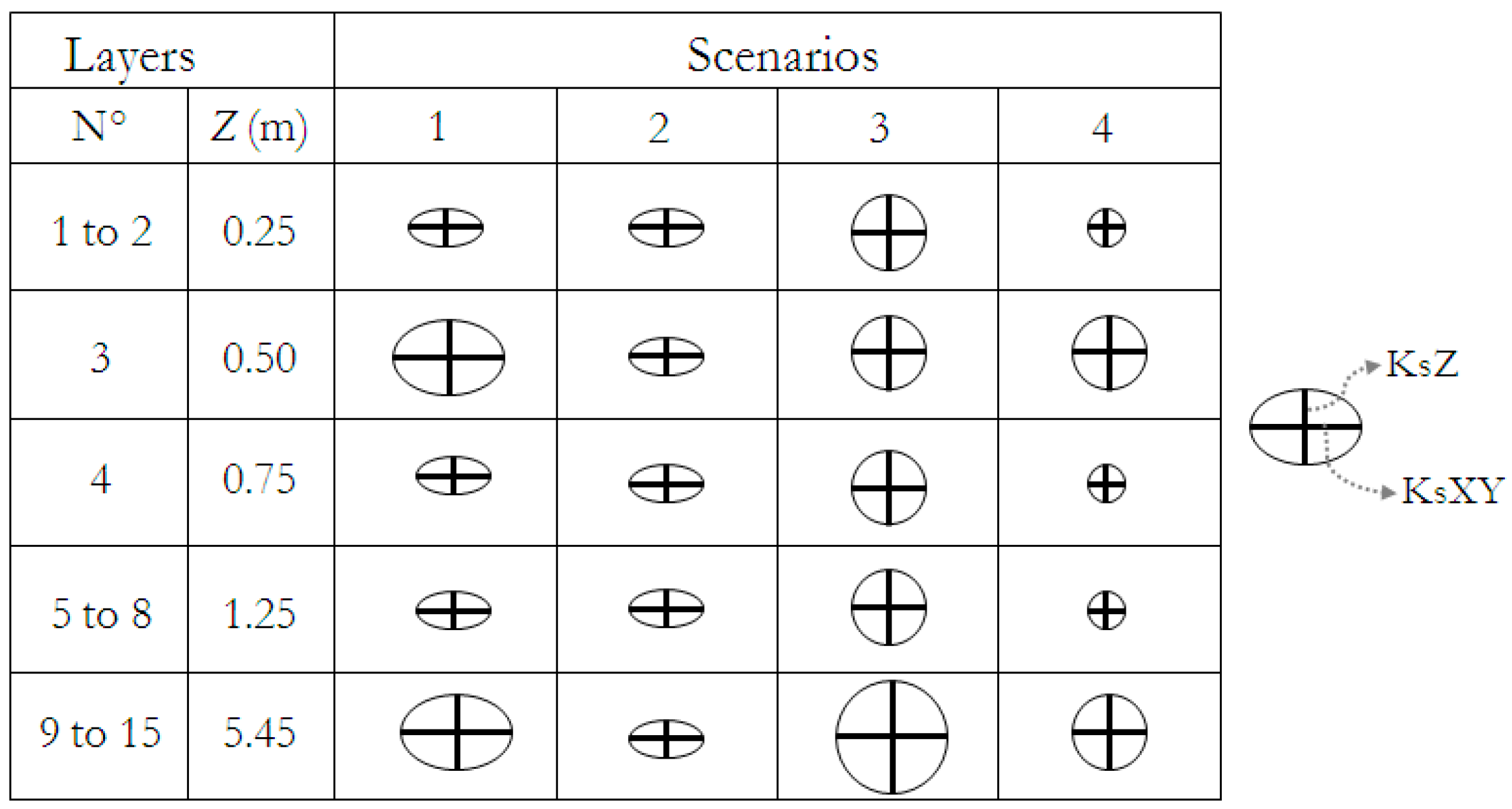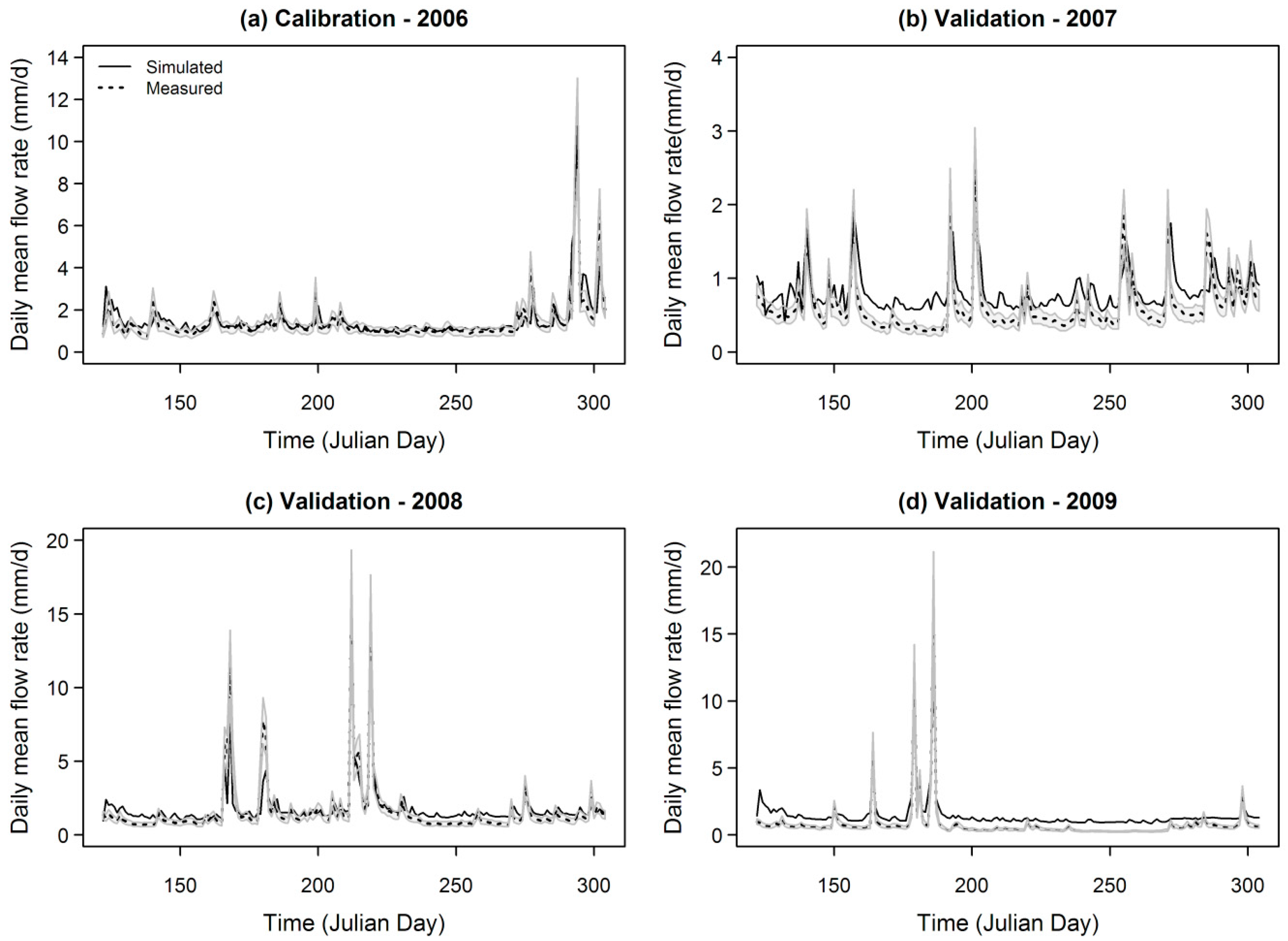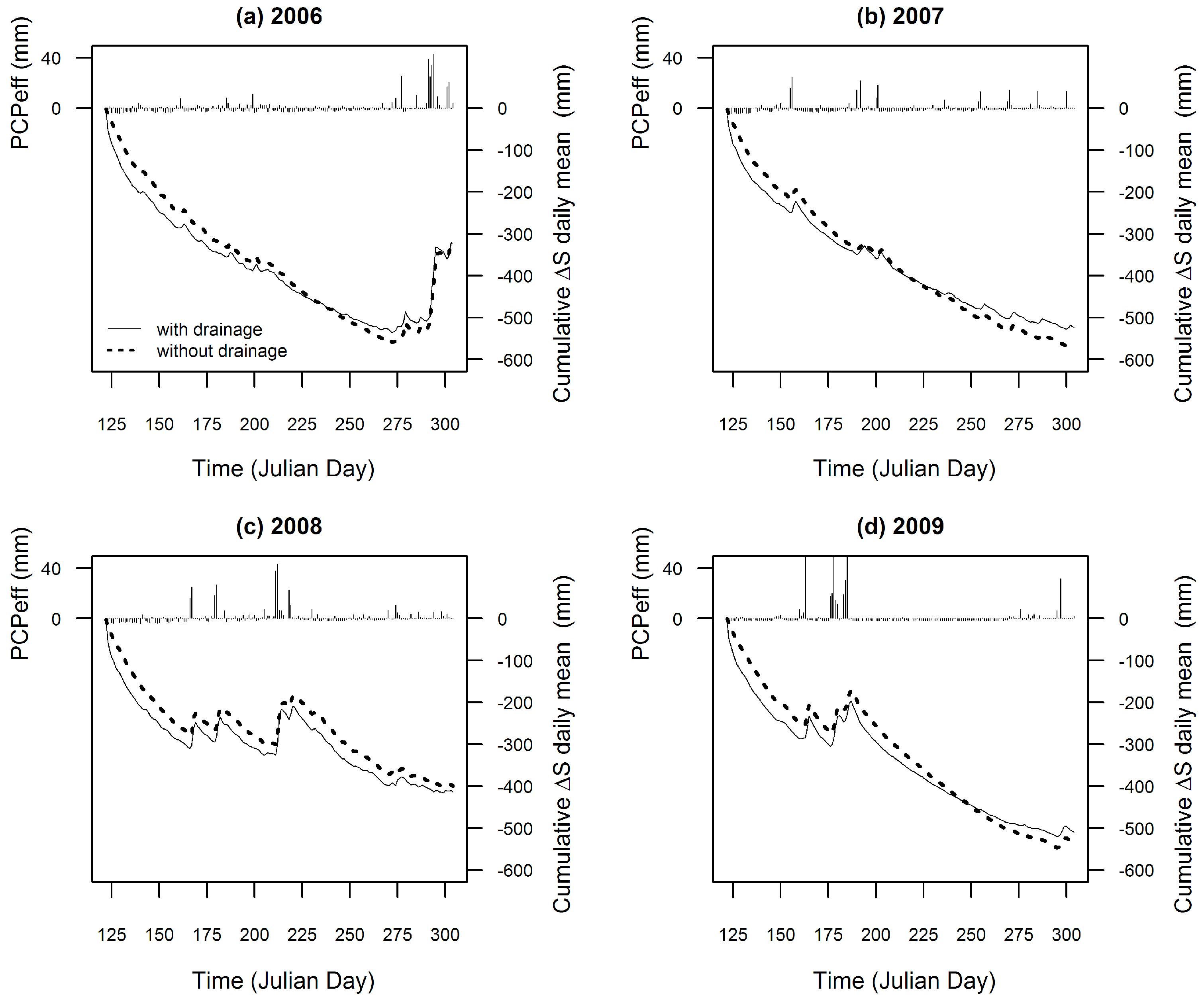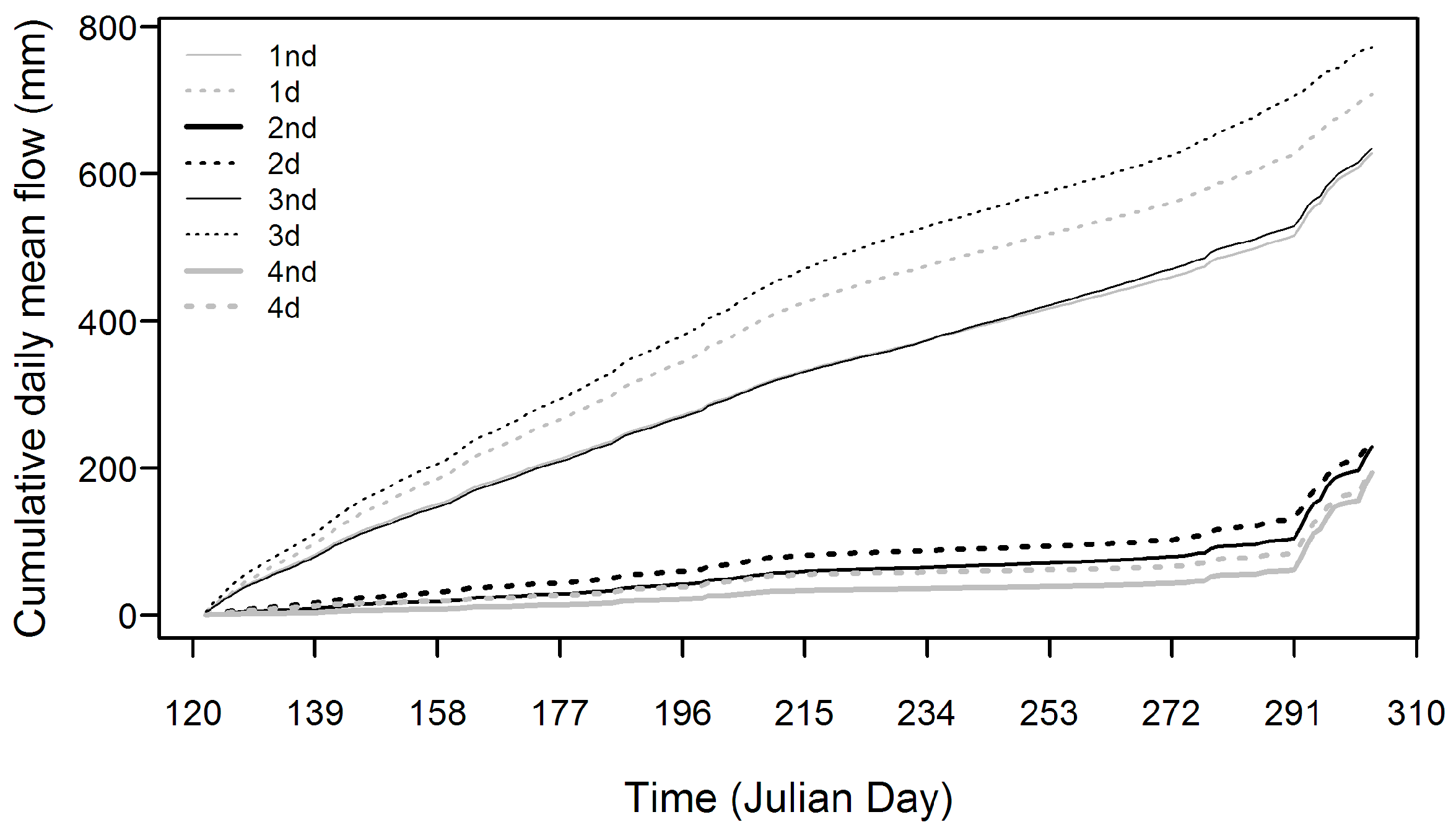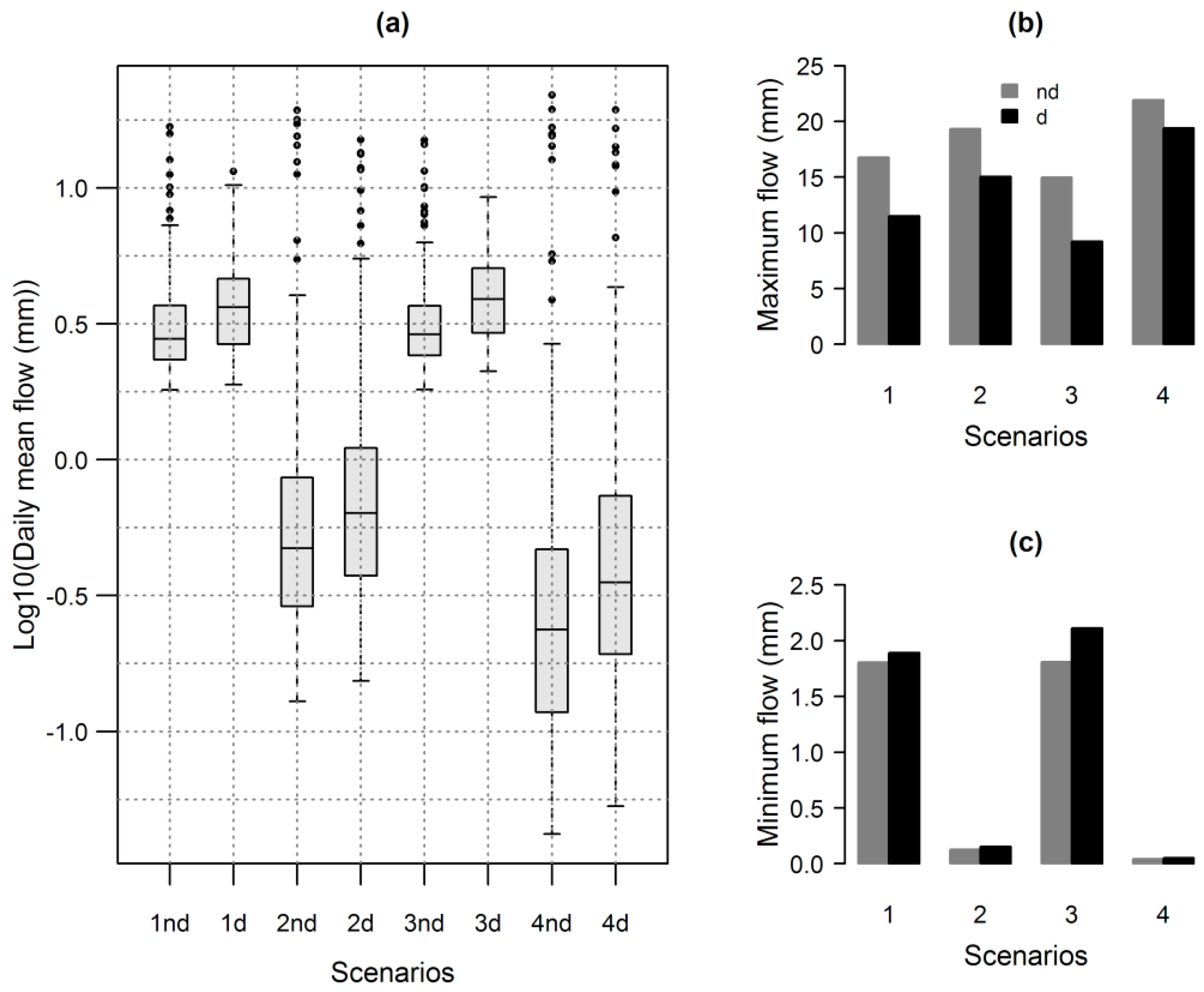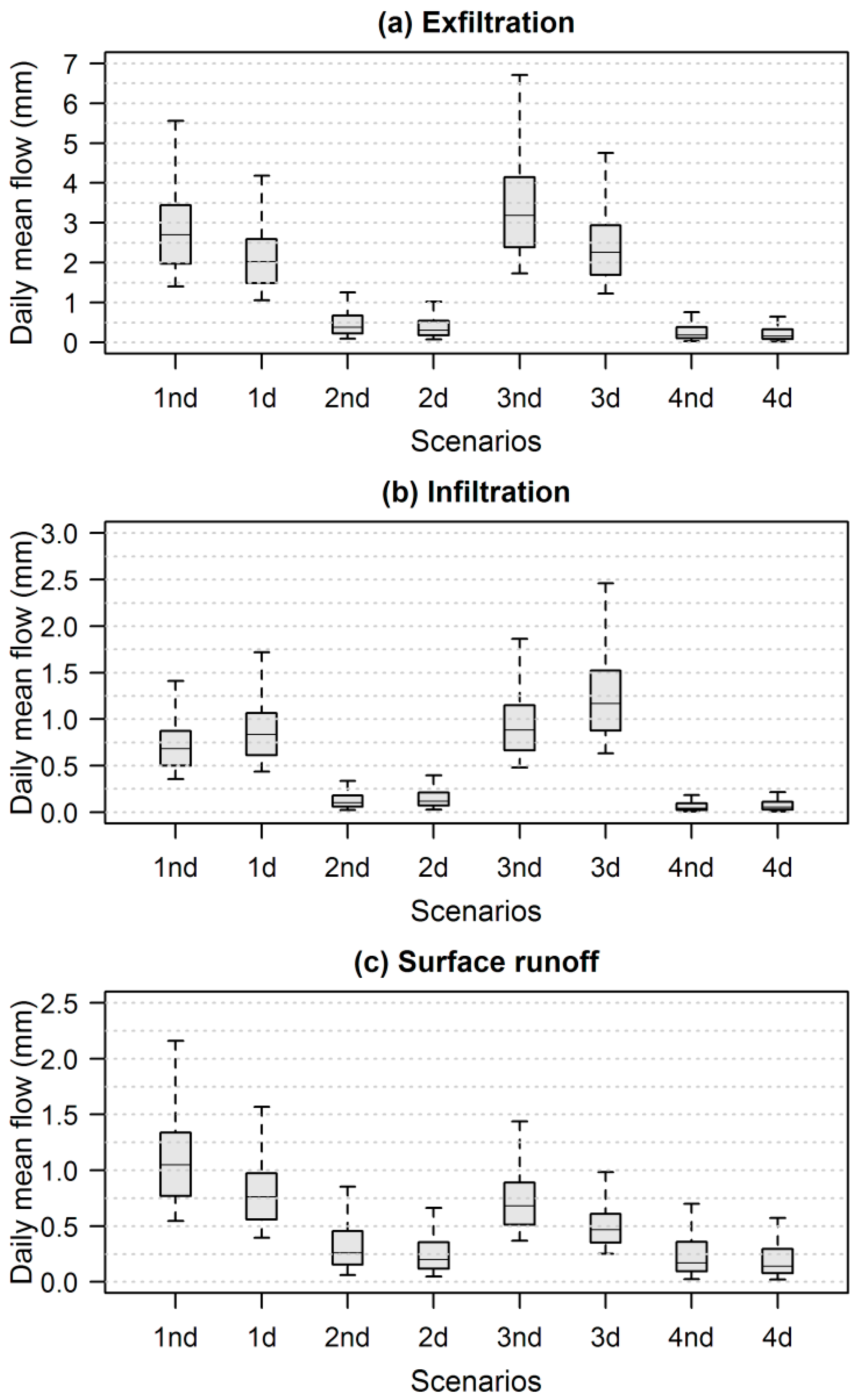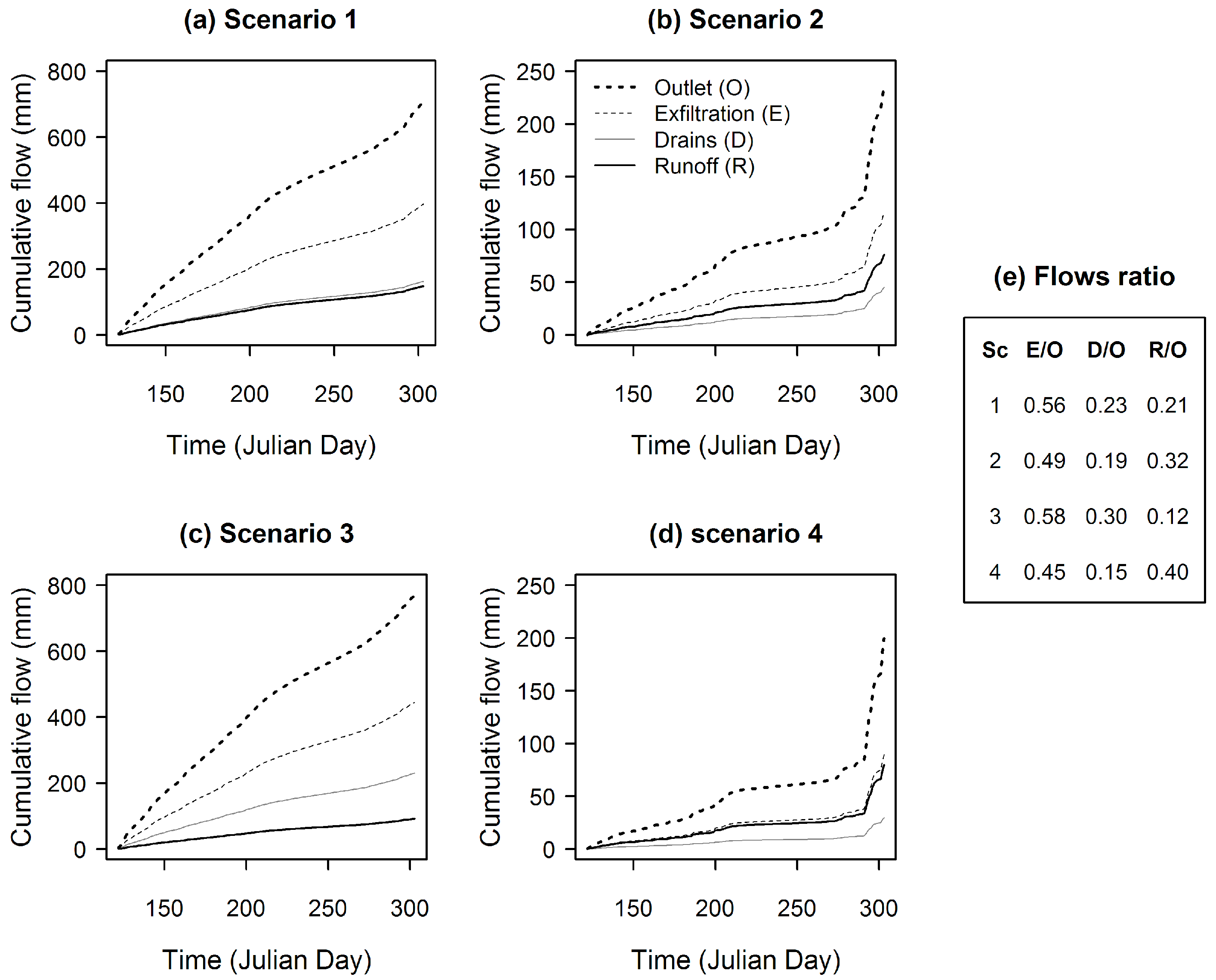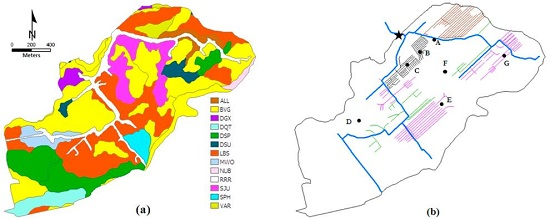1. Introduction
Subsurface drainage is a common agricultural practice to improve aeration and trafficability of soils in regions characterized by seasonal high water tables [
1,
2]. Subsurface drainage system helps to increase crop yield of poorly drained soils by providing a better environment for plant growth, especially during wet periods [
3] and improve field conditions for timely tillage, planting and harvesting [
4,
5].
When subsurface drains are in place, the drainable water fraction of the soil profile is converted to short-term (detention) storage over a period of few hours, days, or weeks, depending on a number of variables [
6]. These include subsurface drain size, depth and spacing, soil type, outlet size/condition, and whether or not under continuous rainfall or snowmelt conditions. When drainable water is removed from the soil profile, infiltration can then occur. This is due to available soil pore space allowing water that would otherwise be stored in the surface depressions to infiltrate and have a direct pathway to downstream flow via the subsurface drains [
6].
Although agricultural production has benefited from agricultural drainage in many regions and countries, there are concerns about potential environmental impacts [
7]. The most dramatic hydrological changes in a landscape occur when the latter is converted from native vegetation to intensive cropping systems. When tile drains are implemented, they can substantially alter the total water yield from a field or small watershed as well as modify the timing and shape of the hydrograph [
8]. Tile drainage increases the proportion of annual precipitation that is discharged to surface waters via subsurface flow relative to the amount that is stored, evaporated or transpired [
9,
10,
11].
From several studies across the Midwestern United States and Canada, discharge from subsurface drains constitutes the majority of stream flow in many agricultural watersheds. It was found that tile drainage contributed 51% of annual stream flow in a headwater watershed in Ohio [
12]. Meanwhile, in a watershed in Ontario, Canada, it was estimated that 42% of annual watershed discharge originated from subsurface drain flow [
13]. Culley and Bolton [
14] and Xue et al. [
15] also estimated that 60% and 86%, respectively, of stream flow was derived from tile drain. Although total water yield from a field tends to increase following installation of subsurface drainage, surface runoff and sediment yields are often significantly decreased [
2,
16,
17]. Subsurface drainage reduces both peak outflows and the frequency of surface runoff events at sites characterized by high water tables or prolonged surface saturation (“ponding”) under undrained conditions [
16,
18].
The main water quality concern about subsurface drainage is the increased loss of nitrates and other soluble constituents (i.e., pesticides and dissolved phosphorus, to name a few) that can move through soils and end up in nearby surface waters. Meanwhile, it is generally agreed that, through the installation of subsurface drainage, the amount of particulate phosphorus and soil transported by surface runoff is decreased because the volume of surface runoff is reduced [
19,
20]. However, dissolved phosphorus loss via artificial drainage has been shown to contribute to the accelerated eutrophication of rivers, lakes, estuaries and even coastal waters, including some of the most challenging cases of agriculturally-derived eutrophication [
21]. On more permeable soils, where infiltration, soil water storage capacity, and lateral conductivity/seepage is large enough to handle a given storm event, subsurface drainage may have the opposite effect for an event of equivalent magnitude, increasing peak flows by increasing the speed of subsurface discharges [
18,
22]. In fields where diffuse pollution dominates, installation of artificial drainage can increase peak flows, which accounts for the majority of phosphorus loss, and hence can improve the hydrological connectivity of otherwise isolated areas of the landscape [
23,
24]. Increased peak flows due to agricultural tile drainage have also been shown to increase channel widening and bank erosion [
25].
The impact of artificial drainage strongly depends on characteristics of an individual site, including: topography (slope), drainage system design (spacing, depth and size of drains) as well as soil type (hydraulic conductivity) [
26,
27]. The hydrological response of subsurface drainage during a given event varies based on event characteristics, such as rainfall amount and intensity [
28], and antecedent soil moisture conditions [
13,
17,
29]. Therefore, there is a need for research to better understand the impact of subsurface drainage at both field scale and catchment scale.
The goal of this study was, using a coupled surface water groundwater hydrological model, to quantify the impact of subsurface agricultural drainage and soil properties on the hydrologic functioning of a micro-watershed under intensive farming of annual crops such as grain corn (Zea mays) or soybean (Glycine max). The specific objectives of this study were: (1) to simulate the micro-watershed outlet flow and analyse the effect of subsurface agricultural drainage on soil water storage variation; and (2) to analyse the impact of drainage networks and soil saturated hydraulic conductivity on: (2a) micro-watershed outlet flow; (2b) surface runoff, surface water and groundwater coupling; and (2c) micro-watershed outlet flow hydrograph.
To our knowledge, although there are studies dealing with testing (evaluation) and application of the coupled surface water groundwater hydrological model used in this study, CATHY (acronym for CATchment HYdrology) [
30,
31,
32,
33,
34,
35,
36,
37,
38,
39,
40,
41,
42,
43], there are no exhaustive studies investigating the influence of artificial subsurface drainage on flows at the watershed level. CATHY is the type of process-based model that is required to study the spatio-temporal variability of soil moisture, groundwater flow and surface runoff. Furthermore, as a virtual laboratory, CATHY provides a powerful deterministic approach to further our understanding of the impact of subsurface drainage on stream flow.
In this respect, not only does this study make a significant contribution to the understanding of CATHY, but it is also the first investigation dealing with the impact of subsurface agricultural drains on the partitioning of flow at a watershed outlet using a 3D model.
2. Materials and Methods
2.1. Study Site
The study site is a micro-watershed of 2.4 km
2 with latitude and longitude of 46°29′00″ N and 71°14′00″ W, respectively, located in the watershed of the Bras d’Henri River which covers approximately 167 km
2, a sub-watershed of the Beaurivage River. The latter is located about 30 km southeast of Quebec City on the south shore of the Saint Lawrence River, within the Chaudière-Appalaches agro-climatic region (
Figure 1). Two-thirds of this drainage area is currently dedicated to agriculture (large-scale farming, pastures, etc.) while the balance remains in its natural state, which includes wooded areas and wetlands.
The region is characterized by long and cold winters, short and cool summers, and significant annual precipitation, approximately 1150 mm/year, a third of which accumulates as snow. During the summer, precipitation is generally greater than the amount of water lost to evapotranspiration. Thus, no water deficit is observed at soil level, except for a slight possibility in certain sectors of coarse sandy soil with gravel and stones which drains well to very rapidly from the plain and this exclusively during the month of July [
44]. The site is covered by the “Watershed Evaluation of Beneficial Management Practices (WEBs)” program, launched nationally in 2004 and managed by Agriculture and Agri-Food Canada (AAC), which aims at measuring the environmental and economic impact of certain Beneficial Management Practices (BMPs) on the quality of water in seven hydrographic micro-watersheds in Canada [
45,
46,
47].
The site is characterized by intensive agricultural production composed essentially of silage (53.1%), grain corn (
Zea mays, 27.8%) and soybean (
Glycine max, 8.1%).
Figure 2a shows the soil codes of the different soil families from the surface to a depth of 1.25 m while the
Table 1 gives their names and percentage of sand, silt and clay. The corresponding geometric means of the soil saturated hydraulic conductivities are given in
Table 2. The location of the drainage systems (at a depth of 1.20 m and occupying 30% of the total area of the watershed) is presented in
Figure 2b.
2.2. Data Source
The database provided by AAC includes meteorological data (average air temperature, relative humidity, saturated vapour pressure, wind speed at an altitude of 2 m, net radiation, precipitation, etc.), saturated hydraulic conductivity of soils up to a depth of 1.25 m obtained from suction tests, and water height data measured every 15 min at the outlet of the micro-watershed by a probe installed above the stream. The water flow rate data were obtained by means of calibration curves (linking flow rate to water height) determined by Ratté-Fortin [
49].
The saturated hydraulic conductivities of the soil at a depth greater than 1.25 m were obtained from permeability tests or slug tests [
50,
51] conducted at the piezometer locations identified in
Figure 2b. The saturated hydraulic conductivity values varied from 3.33 × 10
−6 to 2.08 × 10
−5 m/s with a geometric mean of 1.29 × 10
−5 m/s.
Given the number of soil families and piezometers, the saturated hydraulic conductivity value of each horizon of the soil profile was used to calibrate the hydrological model, the geometric means of each horizon being used as initial values.
2.3. The CATHY Model
CATHY is a spatially-distributed physics-based model that integrates surface and subsurface flows [
52]. The surface flow (in rills and waterway) is generally formulated by the Saint Venant equation:
This equation is resolved numerically by the finite difference method. Since the CATHY model is a rill flow-based model, Equation (1) is represented in a 1D coordinate system s (L) to describe each element of the surface drainage network, where Q is the flow rate along the rivulet/waterway (L3/T), is the kinematic celerity (L/T), is the hydraulic diffusivity (L2/T), and is the input flow rate (positive) in the medium or the output flow rate (negative) from the subsurface to the surface (L3/LT).
Richards 3D equation (Equation (2)), which describes flow in a variably-saturated media (subsurface flow), is resolved numerically in space by the Galerkin finite element method using tetrahedral elements. Since the storage and conductivity terms strongly depend on pressure, Equation (2) is mostly nonlinear and, as a result, is linearized by Picard’s or Newton’s iterative methods [
53]. Thus, the partial differential equation, which mathematically describes the flow in porous media, is:
where
is the saturation level,
is the volumetric water content (-),
is the saturated water content (generally equal to the porosity
),
is the specific storage coefficient (1/L),
is the capillary potential (L),
t is time (T), ∇ is the gradient operator,
is the hydraulic conductivity tensor (LT),
is the relative conductivity function (-),
,
z is the vertical coordinate oriented towards the top (L), and
represents the source (positive) or the well (negative) (L
3/L
3T).
CATHY is a complex hydrological model with different and varied advantages. The surface hydrology links terrain topography, hydraulic geometry and flow dynamics. Its outputs include surface pressure head (or ponding), overland fluxes, subsurface pressure head and moisture content values, and groundwater velocities. Numerous other variables can be derived from these main outputs such as aquifer recharge, catchment saturation, and stream flow. Surface and subsurface contributions to runoff can be computed at any specified surface node within the catchment, and by default also at the catchment outlet, representing the total stream flow at the outlet.
As a robust model, the use of CATHY requires many input data (parameters). In its current version, no dimension of diameter or radius is taken in account regarding the tile-drain representation in the subsurface porous medium.
To our knowledge, there has not been any study involving CATHY and dealing with the equifinality thesis (identifiability of equally-performing sets of parameter values) or estimation of uncertainty. To our knowledge, all reported papers on CATHY have shown that the model has always been calibrated using observed parameter values mainly of soil saturated hydraulic conductivity and soil porosity. This is mostly a result of the large computational time required to run CATHY as reported in our global sensitivity analysis of the model [
48]. It is in this deterministic context that this study was conducted rather than an underestimation of parameter uncertainties.
The subsurface drainage system is represented in the model by assigning a pressure potential (Dirichlet boundary condition) or a flux (Neumann boundary condition) to the corresponding node. More detailed descriptions of the model can be found in the work of Camporese et al. [
52].
2.4. Setting up CATHY at the Watershed Scale
2.4.1. Discretization of the Porous Medium
The application of CATHY was developed on the micro-watershed using a Digital Elevation Model (DEM) with a resolution of 20 m. The porous medium was discretized into 15 layers with thinner layers at the surface and near the nodes located closest to the drainage networks at a depth of 1.20 m (interface of the 7th and 8th layers). This was done to properly account for the interactions between surface and subsurface waters and for the influence of drains on the flow. The discretization of the watershed surface resulted in 6148 cells; each one divided into 2 triangles, producing 12,296 cells (linked by 6391 nodes). The latter cells were projected vertically on the 15 layers with each triangle creating three tetrahedrons. The porous medium was thus represented by 553,320 (12,296 × 3 × 15) tetrahedral elements linked by 102,256 nodes (6391 × (15 + 1)).
The values of the soil hydrodynamic properties, that is the saturated soil hydraulic conductivity in the horizontal (in
X and
Y, or
Ks
XY) and vertical (
Ks
Z) planes, the specific storage coefficient (
Ss), and the porosity (φ), associated with each layer of the porous medium are introduced in
Table 3. In the vertical direction, there are 5 groups of layers: the first group includes layers 1 and 2, the second group layer 3, the third group layer 4, the fifth group layers 5 to 8 (location of the drainage networks), and the fifth group layers 9 to 15 as a whole. The first two layers make up the superior or surface layer where the partition of available water (precipitation) into surface water and infiltration takes place, as well as the superficial transfer.
In this study, four scenarios of saturated hydraulic conductivity values were used. The first scenario (Sc. 1), considered as the baseline scenario, is a non-homogenous medium with anisotropic values in each group of layers as given in
Table 3 and derived from measured saturated hydraulic conductivity values. They were used to calibrate (saturated hydraulic conductivity was the parameter mostly adjusted during this process) and validate the model. In order to analyse the impact of drainage networks and soils on: (a) the flow at the outlet of the micro-watershed; (b) the coupling of surface water and groundwater, and surface runoff; and (c) the hydrograph at the outlet of the micro-watershed, in addition to the baseline scenario, three additional values of saturated hydraulic conductivity were taken into account based on the fact that, when measuring the saturated hydraulic conductivities in situ or in laboratory, their values can fluctuate within a certain range of order 10 (
Table 4). To simplify their visual interpretation, these are represented by circular- or elliptic-shaped diagrams where horizontal and vertical axes represent KsXY and KsZ, respectively (
Figure 3). Scenario 2 (Sc. 2) has a non-homogenous medium with anisotropic layers, Scenario 3 (Sc. 3) is a non-homogenous medium with isotropic layers, and Scenario 4 (Sc. 4) has a non-homogenous medium with isotropic layers. All of these scenarios were applied to the calibration period (year 2006).
In their sensitivity analysis study of CATHY to the soil hydrodynamic properties, Muma et al. [
53] noticed that the saturated hydraulic conductivity of the deeper layers (fifth group of layers) had a significant impact on to drain discharge and outlet of the micro-watershed flow. Furthermore, they revealed that the vertical saturated hydraulic conductivity in the two surface layers (first group of layers) as well as the vertical and lateral saturated hydraulic conductivity in the layers where the subsurface drains are located deserved special attention due to their strong interaction with other parameters with regards to drain discharge. Based on these findings, the hydraulic conductivity in the porous medium is in decreasing order as follows: Sc. 3 > Sc. 1 > Sc. 2 > Sc. 4.
2.4.2. Boundary Conditions and Initial Humidity Conditions in the Soil
The study period stretches from 1 May (121 JD, Julian date) to 31 October (304 JD) of each one of the following years: 2006, 2007, 2008 and 2009. This period, which corresponds to the growing season [
54], is characterized by surface runoff, infiltration, evapotranspiration and intense agricultural activities in the micro-watershed.
Boundary conditions at the surface of the watershed are given by the effective precipitation; that is, real precipitation minus potential evapotranspiration. The latter was calculated by the FAO Penman–Monteith reference evapotranspiration weighted by crop coefficient [
55].
The values of total effective precipitation for the months of May to October are 343, 212, 337 and 382 mm for years 2006, 2007, 2008 and 2009, respectively. For 2006, precipitation was abundant near the end of the simulation period; that is, around mid-autumn (fall). Year 2007 was characterized by low precipitation and the lack of precipitation was seen over a large portion of the spring and summer. The wettest summer was in 2008, with high peaks of precipitation in spring, whereas year 2009 presents a lack of precipitation in summer.
Regional values of mean and median effective precipitation, as well as percentiles 25% and 75%, for the past forty years (1971 to 2010) for the period from 1 May to 31 October are 242, 220, 146, 329 mm, respectively. These regional values were established from the meteorological data in the database for the HYDROTEL model [
56,
57,
58] applied to the Beaurivage watershed [
59]. In this last application, precipitation and temperature were weighted means of the three stations nearest to the study site and the potential evapotranspiration was calculated with the equation developed at Hydro-Québec [
57]. It can be observed that only the percentile 25% is lower than all effective precipitation values for all the years under study. Among the other three statistical measures of effective precipitation (mean, median and percentile 75%), only year 2007 has the lowest value. This confirms once again that not only year 2007 was the driest among the years being studied, but also it was regionally among the driest years over the past forty years.
At the beginning or first time step of each simulation, the initial soil water conditions are given by a water table set at 20 cm under the soil surface. This choice was based on the fact that the beginning of the simulations coincides with the spring season, which corresponds with the thawing period of the soil. It is known that, when the thaw ends, the water accumulated in the depressions infiltrates and reaches the water table to bring it closer to the soil surface in the Saint Lawrence lowlands [
60]. The water table is generally near the surface early in spring, drops significantly during the summer months, and then rises again in the fall [
61]. Furthermore, from a modelling point of view, under these spring conditions drainage systems fulfill their role when the initial water table is so high.
Subsurface drainage systems, located at 1.20 m from the soil surface (at the interface of the 7th and 8th layers), are represented by nodes to which was assigned a zero head pressure (i.e., atmospheric pressure), known as Dirichlet condition.
2.4.3. Variables Analyzed
Figure 4 illustrates the different variables analysed. These are subsurface drain flow and micro-watershed outlet flow, storage variation, surface runoff, infiltration and exfiltration.
2.4.4. Evaluation of Model Performance
To evaluate the performance of the model, three criteria introduced in
Table 5 were used: the error in flow rate peaks (
EP), error in flow volumes (
EV), and Nash–Sutcliffe Evaluation criterion (
NSE).
To account for the errors associated with observed flows from the measurement of water heights up to the establishment of the rating curve, a modified Nash criteria (
NSEm) was used [
62], allowing ±20% error on the observed values as mentioned above. The formula reads as follows:
where
NSEm is the modified Nash criterion and
J is defined as follows:
where
Pi and
Oi represent the simulated and observed flows on day
J, respectively, and
is the arithmetic mean of observed flows during the simulation period. As mentioned above, if a simulated flow is included in the
Ni30–70 values (for those included between
Oi30 and
Oi70), it is deemed sufficient and the value of the numerator
Ji30–70 is zero by definition. Thus,
NSEm is merely the sum of
Ji30 and
Ji70.
Flow measurement from year 2006 was used for the calibration process, whereas years 2007, 2008, and 2009 for the validation process with respect to the performance of the model and the storage variation behaviour according to different effective precipitation shapes.
5. Conclusions
The corner stone of this study was the application of CATHY, a 3D hydrological model, to assess the influence of artificial subsurface drainage on flows at the watershed level. Flows simulated by CATHY at the outlet of the study watershed corroborated well with observed data mostly during wet years. For these years, subsurface water flows easily towards the micro-watershed outlet via drains, allowing the model to properly simulate the flows at the outlet of micro-watershed. Furthermore, simulations were consistent with the traditional approaches of subsurface drainage effects on surface and subsurface components such as base and peak flows, surface runoff, infiltration, and exfiltration.
The development of scenarios aims to support management practices such as the effect of tillage on infiltration or percolation of rain in soil layers. Next to that, when measuring the saturated hydraulic conductivities in situ or in laboratory, their values can fluctuate within a certain range of order 10. The aim of this study was conducted in this context.
These types of studies are needed to build our capacities to manage water resources in agricultural watersheds, where water flow dynamics are often manipulated to increase productivity. A good control of the impact of these manipulations will result in a better understanding of the flows and improved design of management actions to reduce the risks of degrading the quality of surface waters.
